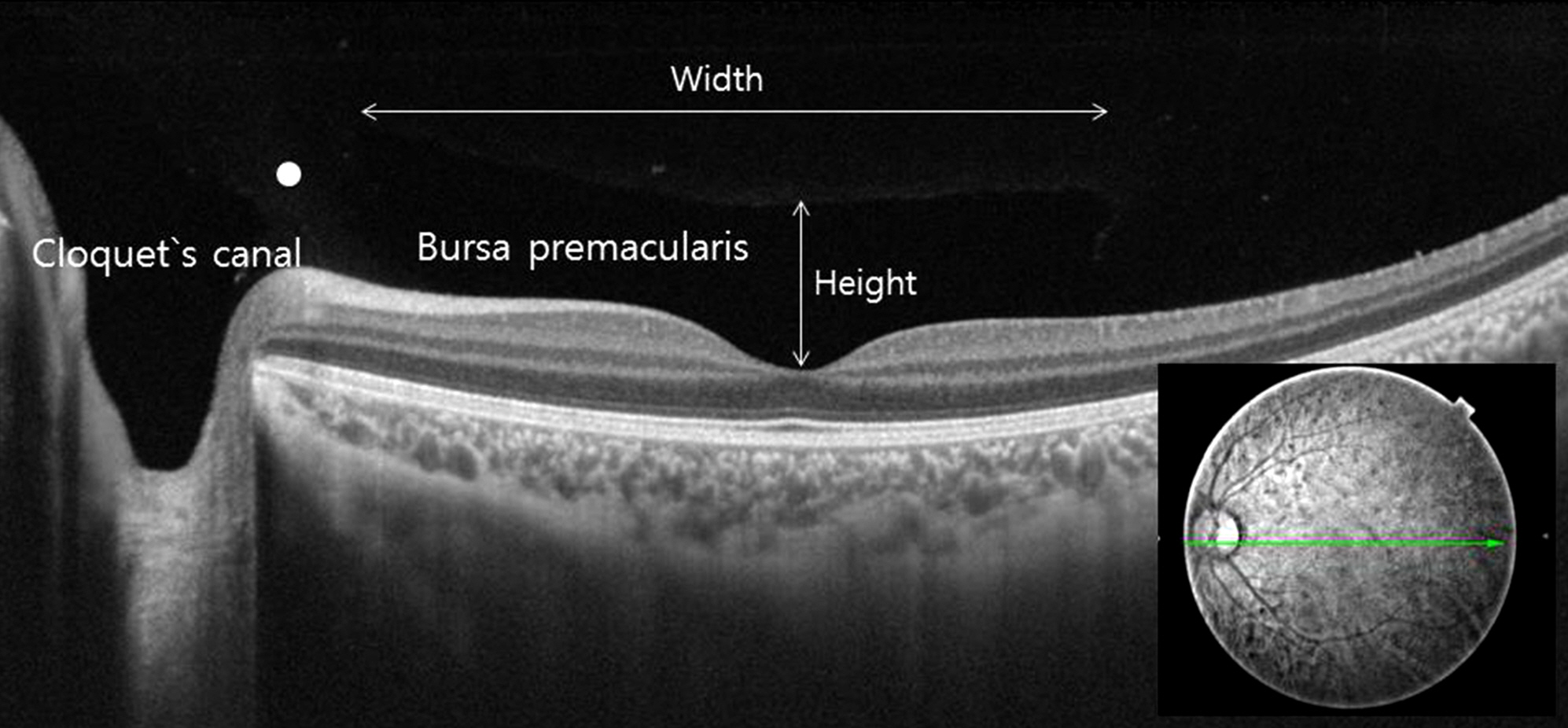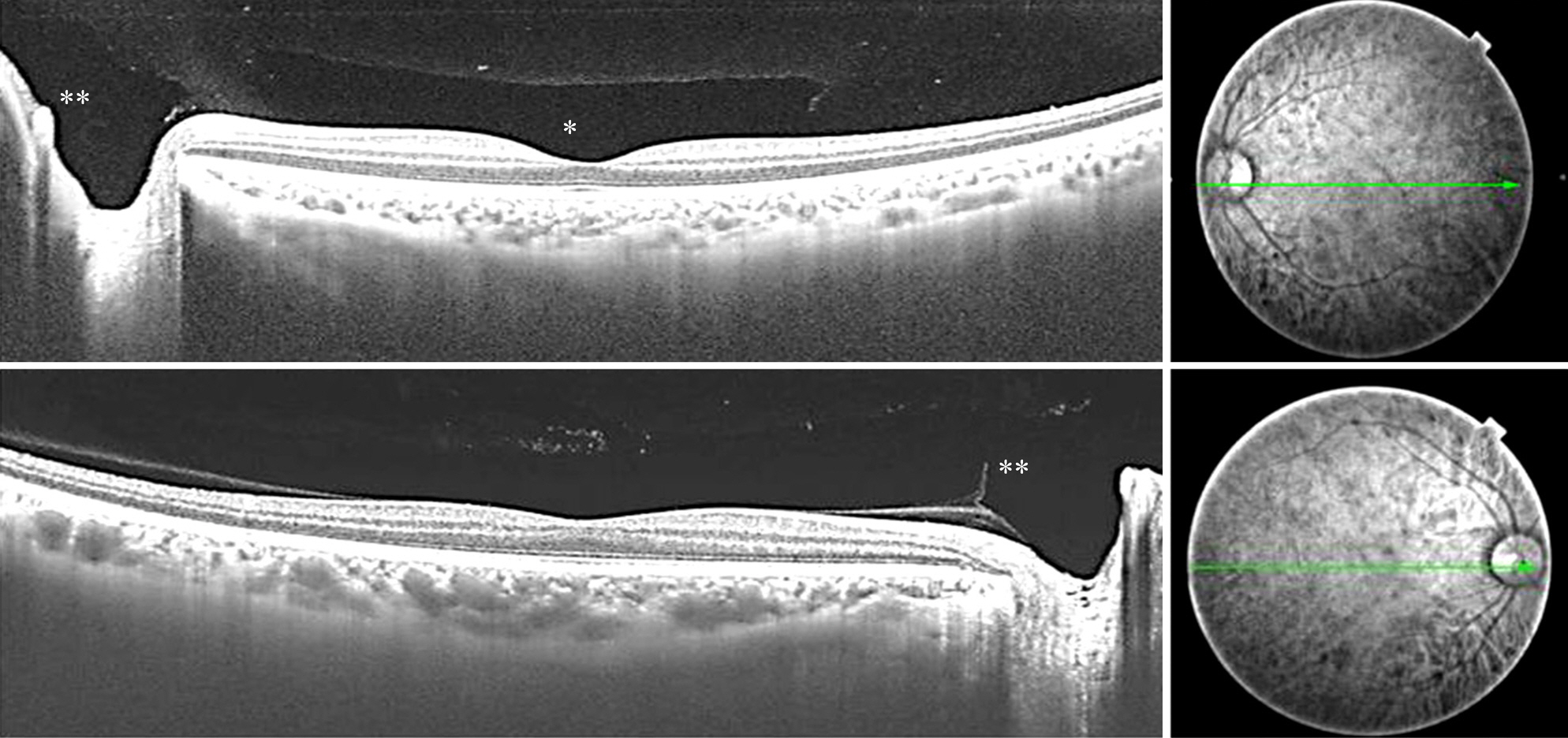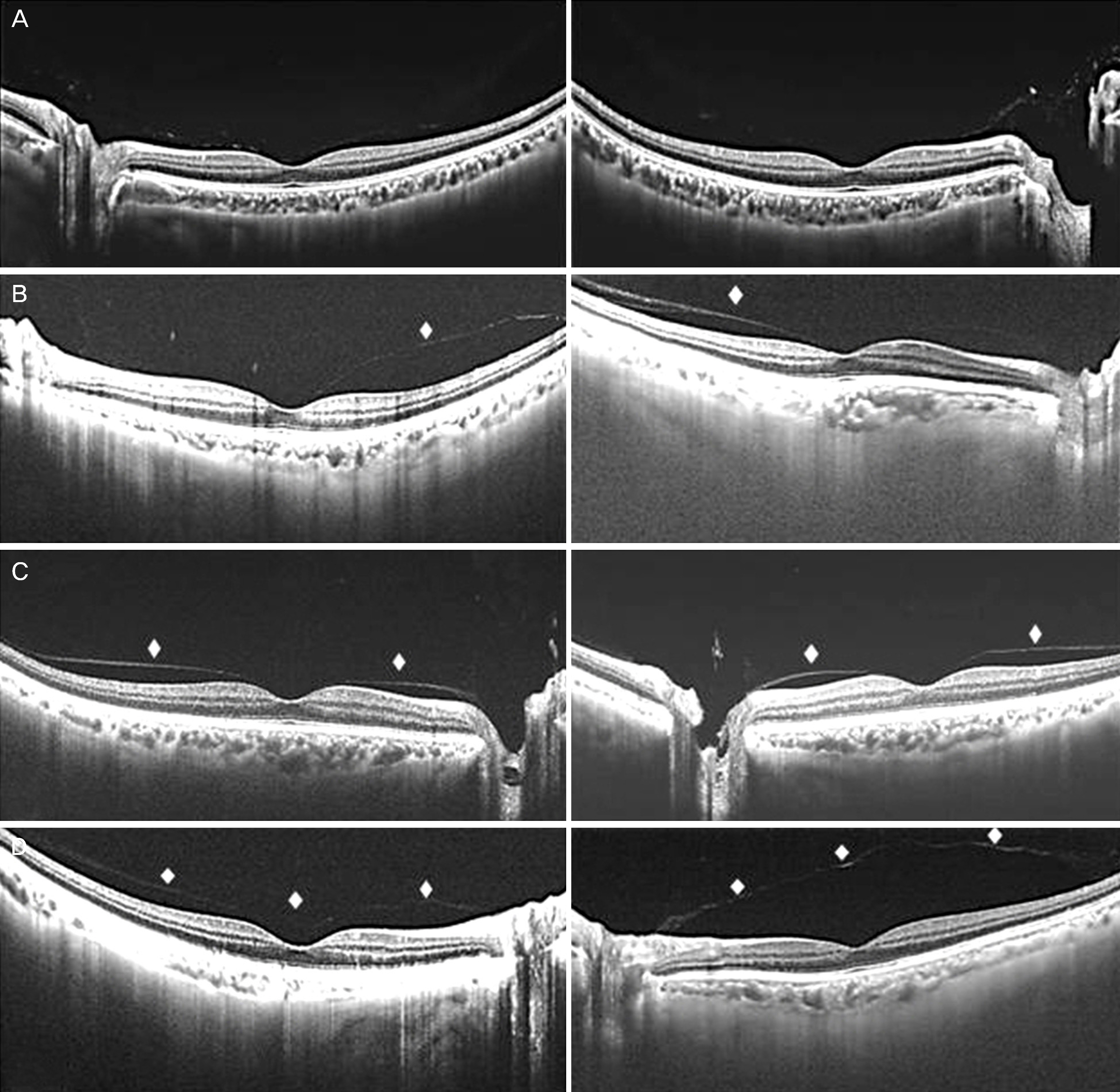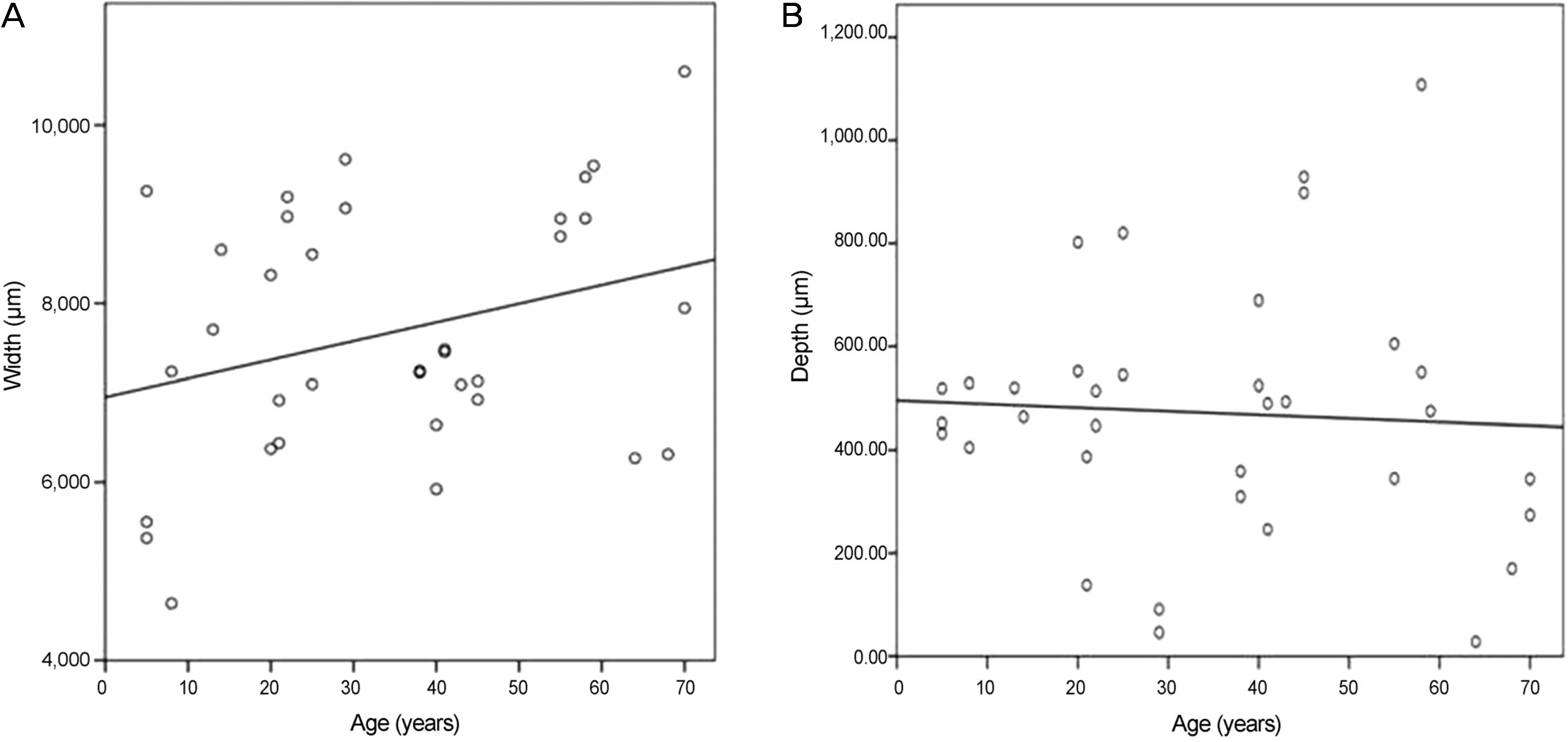J Korean Ophthalmol Soc.
2016 Apr;57(4):595-600. 10.3341/jkos.2016.57.4.595.
Evaluation of the Cortical Vitreous Using Swept-Source Optical Coherence Tomography in Normal Eyes
- Affiliations
-
- 1Department of Ophthalmology, Hanyang University Hospital, Hanyang University College of Medicine, Seoul, Korea. brlee@hanyang.ac.kr
- KMID: 2212793
- DOI: http://doi.org/10.3341/jkos.2016.57.4.595
Abstract
- PURPOSE
To observe the shape of posterior vitreous spaces using swept-source optical coherence tomography (SS-OCT) in normal eyes.
METHODS
The posterior vitreous of 80 eyes of 80 volunteers without ocular disease was imaged. The DRI OCT-1 Atlantis (Topcon, Oakland, NJ, USA) was used to acquire scans of the posterior vitreous over an 18 × 18-mm2 area using the 12-mm horizontal line scan protocol. The size of the premacularis bursa was measured by the aliper function of the OCT.
RESULTS
A boat-shape bursa was found in most cases. The prevalence of detected bursa fell with further increases in the extent of posterior vitreous detachment. The mean width of the bursa premacularis was 7,679.1 µm and the mean depth was 471.4 µm.
CONCLUSIONS
Deep range imaging optical coherence tomography will provide improvement for in vivo anatomic characterization of the cortical vitreous, and allow better visualization of the dimensions of the bursa premacularis.
Figure
Cited by 1 articles
-
Posterior Vitreous Structures Evaluated by Swept-source Optical Coherence Tomography with En Face Imaging
Jun Woo Park, Joo Eun Lee, Kang Yeun Pak
Korean J Ophthalmol. 2018;32(5):376-381. doi: 10.3341/kjo.2017.0123.
Reference
-
References
1. Barteselli G, Bartsch DU, El-Emam S, et al. Combined depth imaging technique on spectral-domain optical coherence tomography. Am J Ophthalmol. 2013; 155:727–32. 732.e1.
Article2. Hoehn F, Mirshahi A, Hattenbach LO. Optical coherence tomography for diagnosis of posterior vitreous detachment at the macular region. Eur J Ophthalmol. 2009; 19:442–7.3. You JY, Kim HC, Moon JW. Comparison of the efficacy between time and spectral domain optical coherence tomography for the identification of vitreomacular interface. J Korean Ophthalmol Soc. 2013; 54:97–103.
Article4. Spaide RF. Measurement of the posterior precortical vitreous pocket in fellow eyes with posterior vitreous detachment and macular holes. Retina. 2003; 23:481–5.
Article5. Park HY, Shin HY, Park CK. Imaging the posterior segment of the eye using swept-source optical coherence tomography in myopic glaucoma eyes: comparison with enhanced-depth imaging. Am J Ophthalmol. 2014; 157:550–7.
Article6. Worst JG. Cisternal systems of the fully developed vitreous body in the young adult. Trans Ophthalmol Soc U K. 1977; 97:550–4.7. Yokoi T, Toriyama N, Yamane T, et al. Development of a premacular vitreous pocket. JAMA Ophthalmol. 2013; 131:1095–6.
Article8. Kishi S, Shimizu K. Posterior precortical vitreous pocket. Arch Ophthalmol. 1990; 108:979–82.
Article9. Fisher YL, Slakter JS, Friedman RA, Yannuzzi LA. Kinetic ultrasound evaluation of the posterior vitreoretinal interface. Ophthalmology. 1991; 98:1135–8.
Article10. Perichon JY, Brasseur G, Uzzan J. Ultrasonographic study of posterior vitreous detachment in emmetropic eyes. J Fr Ophtalmol. 1993; 16:538–44.11. Shin YU, Lee BR, Lim HW. A comparison of image quality between swept source optical coherence tomography and spectral domain optical coherence tomography according to ocular media opacity. Invest Ophthalmol Vis Sci. 2014; 55:3359.12. Park SM, Cho SW, Lee TG. Swept source optical coherence tomography findings in gas-filled eyes after macular hole surgery. J Korean Ophthalmol Soc. 2015; 56:1386–91.
Article13. Itakura H, Kishi S, Li D, Akiyama H. Observation of posterior precortical vitreous pocket using swept-source optical coherence tomography. Invest Ophthalmol Vis Sci. 2013; 54:3102–7.
Article14. Stanga PE, Sala-Puigdollers A, Caputo S, et al. In vivo imaging of cortical vitreous using 1050-nm swept-source deep range imaging optical coherence tomography. Am J Ophthalmol. 2014; 157:397–404.e2.15. Itakura H, Kishi S. Alterations of posterior precortical vitreous pockets with positional changes. Retina. 2013; 33:1417–20.
Article16. Uchino E, Uemura A, Ohba N. Initial stages of posterior vitreous detachment in healthy eyes of older persons evaluated by optical coherence tomography. Arch Ophthalmol. 2001; 119:1475–9.
Article17. Mojana F, Kozak I, Oster SF, et al. Observations by spectral-domain optical coherence tomography combined with simultaneous scanning laser ophthalmoscopy: imaging of the vitreous. Am J Ophthalmol. 2010; 149:641–50.
Article18. Itakura H, Kishi S. Aging changes of vitreomacular interface. Retina. 2011; 31:1400–4.
Article19. Li D, Kishi S, Itakura H, et al. Posterior precortical vitreous pockets and connecting channels in children on swept-source optical coherence tomography. Invest Ophthalmol Vis Sci. 2014; 55:2412–6.
Article
- Full Text Links
- Actions
-
Cited
- CITED
-
- Close
- Share
- Similar articles
-
- Peripheral Lattice Degeneration Imaging with Ultra-Widefield Swept-Source Optical Coherence Tomography
- Posterior Vitreous Structures Evaluated by Swept-source Optical Coherence Tomography with En Face Imaging
- Comparison of Image Quality between Swept-Source and Spectral-Domain Optical Coherence Tomography According to Ocular Media Opacity
- Swept Source Optical Coherence Tomography Findings in Gas-Filled Eyes after Macular Hole Surgery
- Utility of the Swept Source Optical Coherence Tomography for Measurements of Central Corneal Thickness





